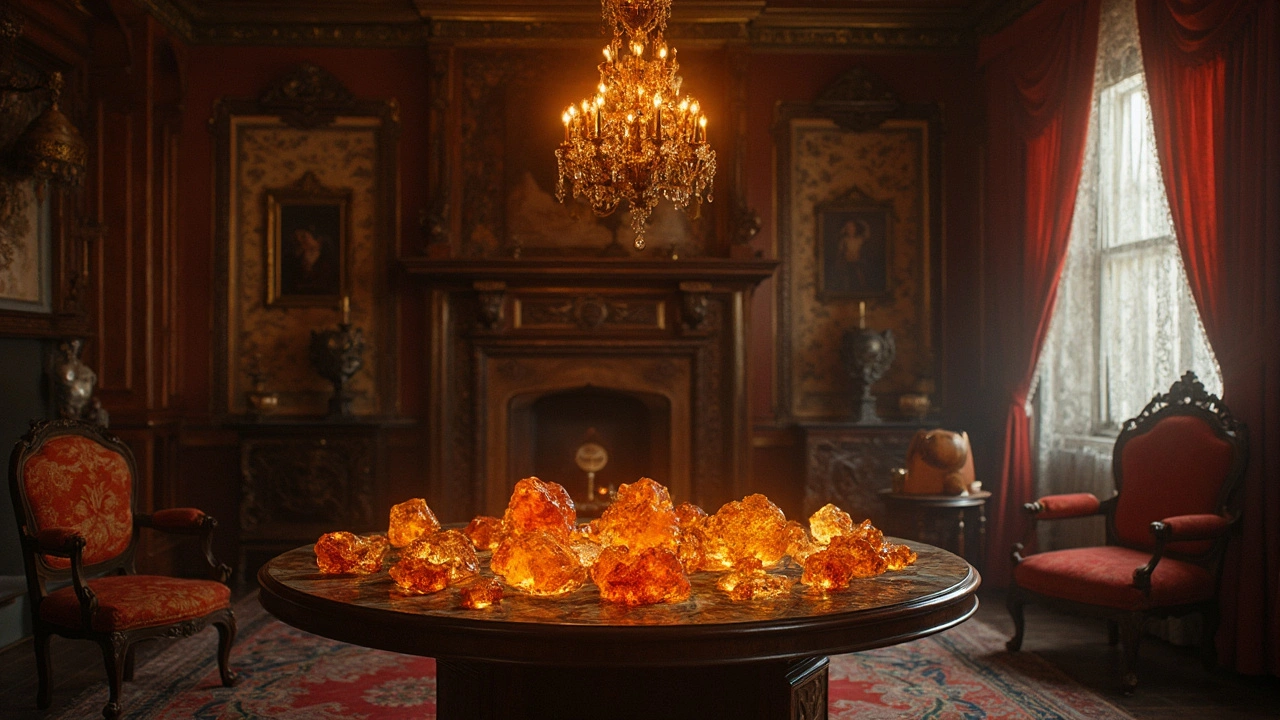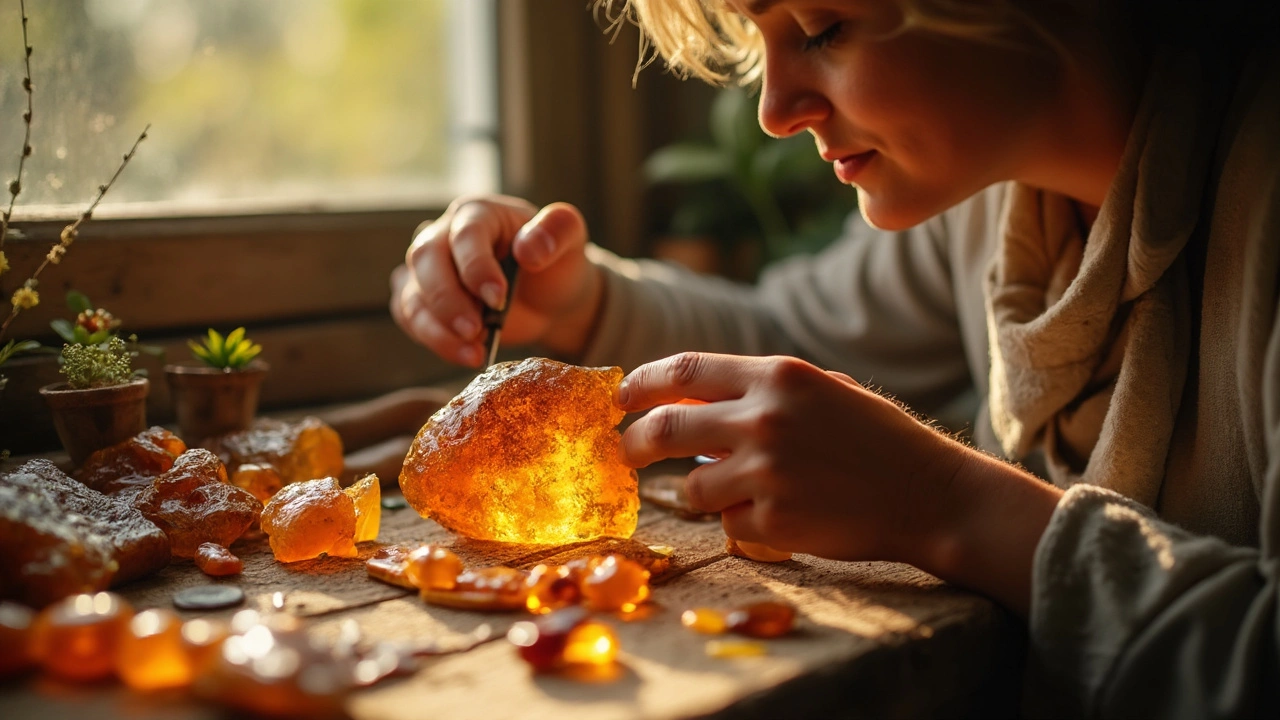Amber is something you might have heard of but aren't really sure what's so special about it. Well, it's not just any gemstone; it's actually fossilized tree resin that has been cherished for its beauty and glow. If you've ever wondered why it's so admired, it's possibly because of the warm, honey-like colors and the fascinating history behind it.
People have used amber in jewelry and for trade for thousands of years. It isn't just pretty on the outside; it's got stories of ancient forests locked inside. Recognizing good quality amber isn’t always easy, especially with some clever fakes out there. Real amber will often float in salty water and has a warm-to-the-touch feeling.
Amber isn't just a relic from the past. Nowadays, it's back in style and more popular than ever. From elegant necklaces to modern artsy pieces, there's a way to incorporate amber into various designs. And if you own some, there's more to keeping that glow than just wearing it—be gentle and avoid storing it in direct sunlight.
- Unveiling Amber: What Makes It Special
- History and Cultural Significance of Amber
- Identifying Quality Amber Gems
- Modern Uses and Popularity of Amber
- Tips for Caring for Your Amber
Unveiling Amber: What Makes It Special
Amber isn't your typical stone. It's not even a stone at all. It's actually fossilized resin from ancient trees. Over millions of years, this resin hardened into the beautiful, warm amber gems we know today. Those glowing yellow and golden hues? That's the result of centuries of nature's work, giving each piece a unique story.
How is Amber Formed?
The formation of amber is a time-consuming process. It starts when trees get injured and release a sticky substance called resin. Normally, resin would just wash away or decompose. But under the right conditions, it gets buried under layers of soil and sediment. With pressure and time, it slowly turns into amber escort.
Interestingly, some ambers contain preserved insects or plant material. These inclusions were trapped when the resin was still sticky, providing a fascinating glimpse into our planet's ancient past.
Amber's Radiant Colors
The most common color is a rich golden-yellow, but amber comes in other shades like red and green. Factors like the type of tree the resin came from and the environmental conditions where it fossilized influence these colors.
Why is Amber Special?
- Oldest form of gemstone: Some *amber* is over 100 million years old.
- Unique inclusions: It's like a mini time capsule with historical treasures inside.
- Natural glow: Amber has the ability to kind of light up when it catches the light, making it appealing in jewelry.
Pretty neat, huh? That's why people collected amber way back from ancient times, either to admire its beauty or to appreciate its supposed healing powers. Even today, amber isn't just a pretty accessory; it carries cultural significance and historical value. So, next time you see an amber piece, remember, it's more than just a gem—it's a piece of history!
History and Cultural Significance of Amber
The journey of amber as a valued material stretches back thousands of years. It was once traded as a form of currency in ancient markets across Europe and Asia, showcasing its perceived value and allure. The ancient Greeks and Romans admired its natural beauty, considering it a luxury item for the wealthy.
Throughout history, different cultures have attributed various meanings and properties to amber. For the Egyptians, it was considered a powerful healing stone, believed to cure ailments and ward off evil spirits. The ancient Chinese often carved it into talismans for luck and protection.
Amber in Ancient Trade
Amber trade routes were established as early as the Bronze Age in Europe. Known as the "Amber Road," these pathways connected the Baltic regions, rich in amber deposits, with the Mediterranean and Near East markets. This network facilitated not just the exchange of goods, but also cultural interactions across regions.
Cherished for its warm colors and delicate texture, amber was often used in the crafting of jewelry, ornaments, and religious artifacts. It played a pivotal role in artistic expression and was a symbol of status and wealth.
Modern Interpretation
Today, amber continues to hold cultural significance. It represents warmth, healing, and longevity. Collectors and enthusiasts often seek out pieces with inclusions—tiny plants or insects trapped within the resin—resulting in unique and precious artifacts that are both scientifically interesting and aesthetically pleasing.
Though technology has brought synthetics, genuine amber remains highly sought after. Its timeless appeal connects us with ancient traditions and the natural world. Amber encapsulates the blend of history, beauty, and mystery, making it timeless in its relevance and desirability.

Identifying Quality Amber Gems
Knowing how to spot high-quality amber gems can save you from falling for look-alikes or fakes. While amber is a beautiful gem in its own right, there are a few key characteristics to watch for when determining if your amber is the real deal.
Check for Authenticity
A simple way to test is buoyancy. Genuine amber will float in saltwater. To do this, mix about seven teaspoons of salt with a glass of water. Real amber should float while most fakes sink like stones.
Look for Imperfections
Unlike synthetic copies, true amber often has little imperfections or inclusions, such as tiny bubbles or plant debris. These natural occurrences are signs of authenticity and add to the character of the gem.
Verify with Light
Under ultraviolet light, real amber will glow a pale blue or green. This is often a giveaway, as many artificial versions simply won’t react the same way.
Scratch Test
This method should be used cautiously. Amber is relatively soft, so a gentle scratch on the surface with a pin might leave a mark, whereas hard plastic fakes won't scratch as easily. However, always consider testing on a non-visible area to avoid any potential damage.
Scent Test
Gently heat your amber piece; authentic amber emits a resinous smell when heated. Fakes usually give off a more plastic-like odor.
Modern Uses and Popularity of Amber
There's something about amber that keeps it in vogue, even as trends shift. Maybe it's that warm glow that instantly adds a touch of class and elegance. One of the easiest ways to bring amber into daily life is through jewelry. Think necklaces, earrings, bracelets—anything that can highlight that honey-hued charm. Celebrities and influencers, too, often sport amber pieces, giving them that extra pop in public appearances.
But jewelry isn’t the only game in town. Amber is increasingly finding its place in home decor. Imagine having a beautiful amber bowl or candle holder that not only looks stunning but also catches the light in a cozy way. It’s that versatility that makes it sought after.
Fashion Meets Function
Beyond style, amber has been credited with having certain benefits. Some believe it has healing properties, like relieving stress or even physical pain. Whether you believe in that or not, it's clear folks love feeling good about the things they own.
There’s also the cool factor of giving new life to ancient material. Amber is often referred to as “the gold of the north,” and owning a piece connects you to a tradition that’s older than almost anything else in your home.
“Amber is timeless, blending ancient history with modern elegance,” notes Gemma Curtin, an expert in gemstone jewelry.
Captivating Collectors
For those with a collector's heart, amber offers an appealing venture. Rare pieces with inclusions—insects or plant material trapped inside—are like tiny time capsules, freezing moments from millions of years ago. These aren't just collectibles but conversation starters.
Despite its ancient origins, amber is flying high in modern times. Whether it's through fashion, decor, or just plain fascination, amber’s charm seems eternal. It's no wonder so many people are drawn to its warm embrace.

Tips for Caring for Your Amber
Taking care of your amber gems helps keep their beauty and value intact. Even if you think it's just a piece of resin, treating it well ensures it stays in top condition for years to come.
Clean Gently
Avoid using harsh chemicals or cleaning agents when cleaning amber. Instead, go for a soft, damp cloth and gently wipe it down. You don't need to scrub; a light touch is enough to remove any surface dust or dirt.
Keep Away from Heat
Amber is not a fan of heat. High temperatures or direct sunlight can cause it to become brittle or even change color. Always store your amber pieces in a cool, shaded place.
Avoid Scratches
Amber is softer than most gemstones, so it's easily scratched. Keep it separate from harder objects like other stones or metals, especially in storage.
Best Storage Practices
- Wrap each piece in a soft cloth to prevent scratches.
- Store it in a cool, dry place away from direct sunlight.
- Avoid placing it in a drawer or box with other jewelry that might rub against it.
Doing Repairs
If your amber piece needs repair, take it to a professional. Amber can be delicate, and it's worth having a pro handle any serious issues to avoid further damage.
Useful Table on Amber Care Scores
| Aspect | Score out of 10 |
|---|---|
| Scratch Resistance | 6 |
| Heat Resistance | 4 |
| Ease of Cleaning | 8 |
